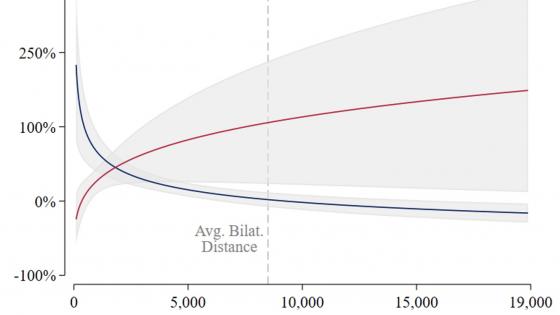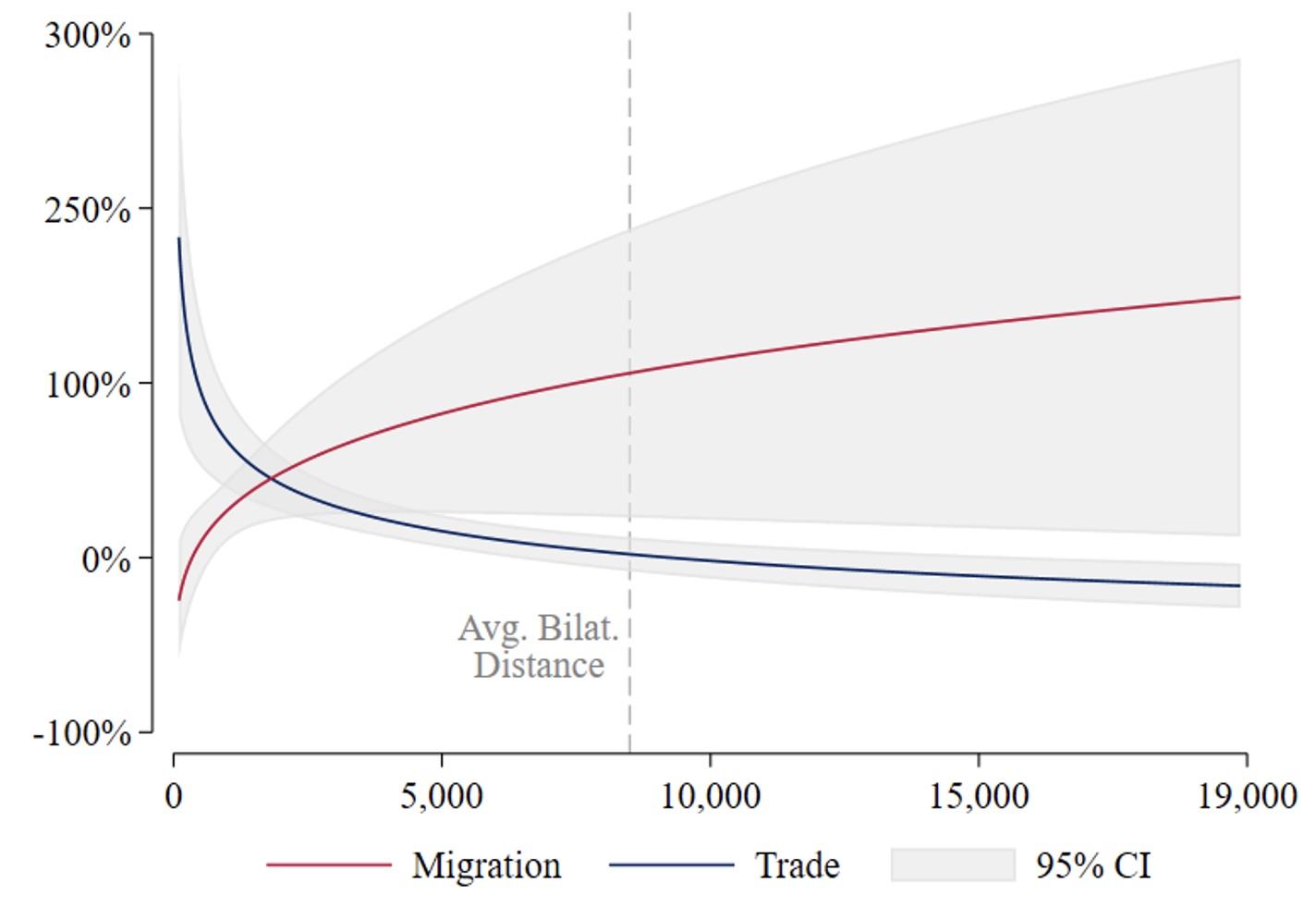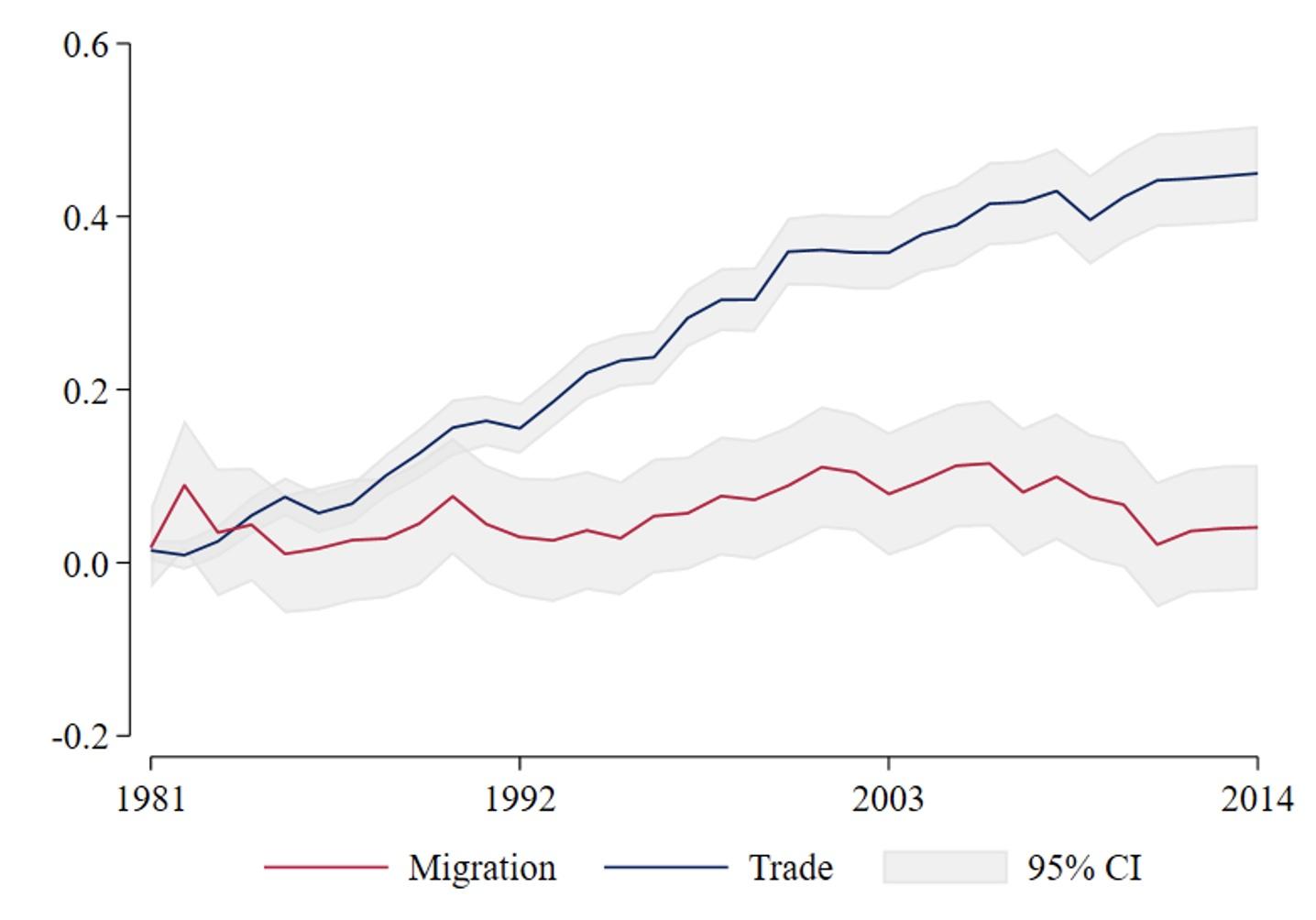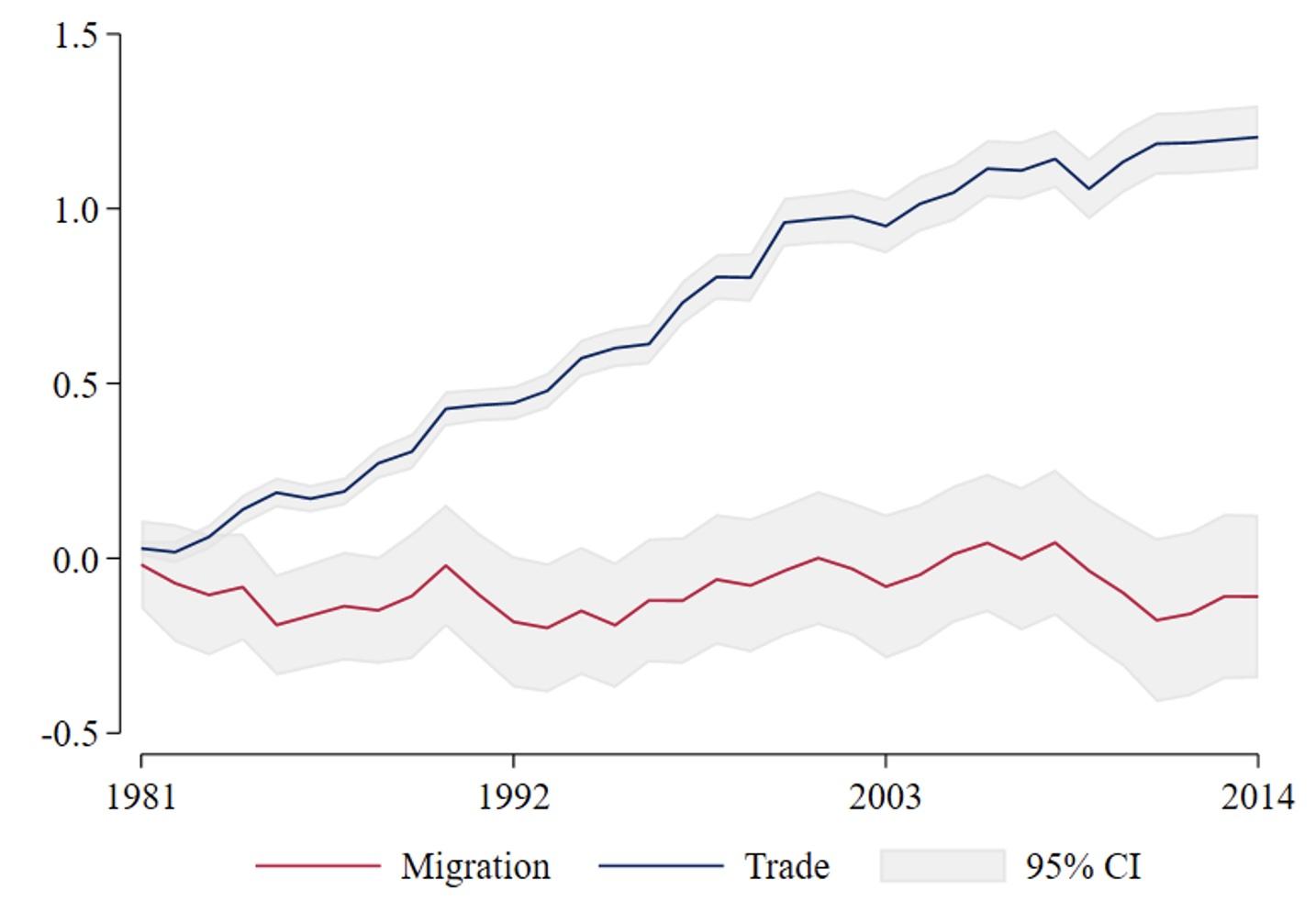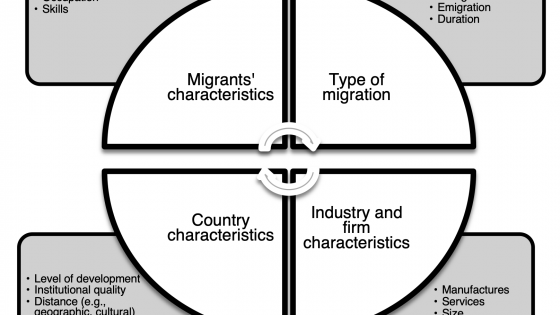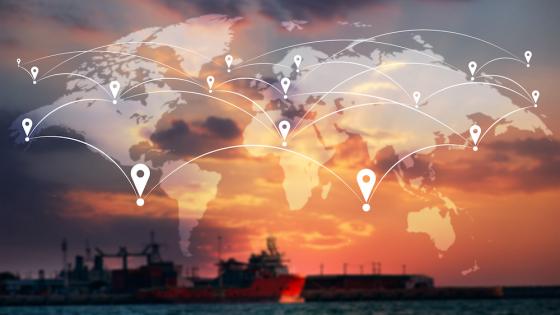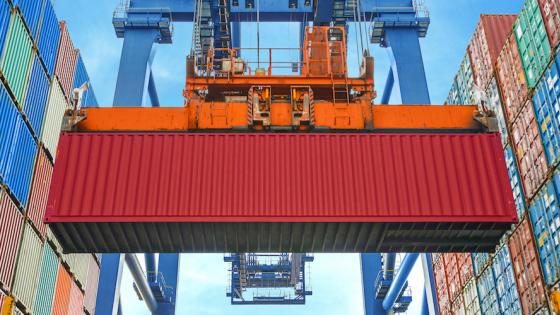Globalisation has many drivers and many consequences. Over the past decades, innovations such as the internet, containerisation, the growth of air travel, better telecommunications, and improved transport infrastructure have all played a role (Freund and Weinhold 2004, Bernhofen et al. 2016, Hummels 2007, Sachs 2020). In parallel, on the policy side, governments have enacted regional trade agreements (RTAs) and freedom of movement agreements (FMAs) to lower barriers to the movement of goods and people across borders, respectively. But whilst there are some common drivers and ‘globalisation’ is often used as a catch-all term, it is not necessarily a uniform process which affects all cross-border flows in the same way or at the same speed. This poses important questions for policymakers and economists seeking to understand how the globalisation process has reshaped trade and migration flows, such as:
- How does distance affect how RTA (FMA) policies boost trade (migration) between signatories?
- How has the drag of distance on each type of flow changed over time?
- How have border frictions for trade and migration flows changed over time?
On the trade side, empirical studies have long confirmed that RTAs boost trade flows between partners (see Limão 2016 for a survey). More recently, it has also come to light that the greatest boost to trade is likely to come from signing agreements with nearby partners (Baier et al. 2018, Freeman and Pienknagura 2018), and that distance and border frictions have declined over time, fostering international trade flows (Bergstrand et al. 2015).
On the migration side, the literature is somewhat smaller, but has similarly found that FMAs boost migration between signatories (Bertoli and Fernández-Huertas Moraga 2015). Further, Lewis and Swannell (2018) find evidence that the elasticity of distance declines under FMAs. But relatively little is known about the effects of distance and border frictions over time on migration, or the effect of distance on the total boost to migration flows associated with signing an FMA.
In recent work (Freeman and Lewis 2021), we apply recent advances in gravity models to explore the questions above under a common econometric framework. By using an identical approach for trade and migration specifications, our analysis demonstrates that the important differences between trade and migration results in gravity models stem from underlying economic mechanisms rather than differences in estimator employed, functional form, control variables, or any other econometric feature.
The boost from RTAs is larger for closer signatories but the boost from FMAs is larger for more distant signatories
To answer the first question, we combine data on bilateral trade flows, RTAs, migration flows, FMAs, and distance for a set of 182 countries over years 1980–2014. Examining the interaction between distance and RTAs confirms the multiplicative nature of trade agreements and proximity. On the other hand, we find significant and increasing returns to FMAs with distance.
Using the estimated coefficients, we calculate the implied percentage boost to flows across the range of bilateral distances observed in our dataset (Figure 1). For RTAs, that boost declines with distance, falling relatively quickly at first. What might the economic mechanisms be? At shorter distances transport costs are low, so the distant-invariant costs (paperwork, delays at the border, etc.) account for a higher proportion of overall costs. Because RTAs act on the latter, they lead to a larger percentage reduction in trading costs when signatories are close together. Taking this to the data, Freeman and Pienknagura (2019) demonstrate that supply chain activity, which is characterised by trade in intermediate goods, is the key channel through which RTAs create additional trade between closer signatories. Proximity plays a crucial role for just-in-time delivery and supply chain development (Pisch 2020, Conocni et al. 2020), so these trade flows are unlocked more by RTAs when distances between signatories are short.
Figure 1 Agreement effect by distance (km)
On the flip side, the boost to migration flows from FMAs increases with bilateral distance, rising relatively quickly at first. One possible explanation could be that FMAs help overcome distance-related search frictions because they permit individuals to migrate first, and then search for a job; whereas without an FMA moves are more likely to require a job offer first. In all likelihood, search frictions are greater over longer distances: it’s relatively easy for someone in Munich to cross the border and travel to Innsbruck for job search activity, interviews, and so on, but far harder for a Londoner to do the same to look for work in Sydney. And so, by eliminating the need to search from distance, FMAs have a larger effect for more distant signatories.
The falling drag of distance on trade flows over recent decades is not seen for migration flows
An important feature of our data is that we have information on both domestic trade and migration flows. Intuitively, this allows us to identify the changing role of distance on trade (migration) outcomes by allowing for an explicit consideration of the choice to produce for the domestic market (remain at home) versus exporting (emigrating) overseas.
To do so, we interact countries’ bilateral distance with time dummies, applying the method pioneered by Yotov (2012) when examining the distance puzzle for trade. Implementing this approach, we find an important difference between the role of distance on trade and migration flows over time (Figure 2).
Figure 2 Distance estimates by year
Distance has a negative impact on both bilateral trade and migration flows, i.e. distant countries trade less with one another and further distances hinder migration.
Thus, when the (blue) trade lines rises, this means that the overall distance effect becomes less negative over time. That is, distance is exerting a progressively smaller drag on trade over time. The intuitive explanation for this result is that improvements in transport and communications have lowered the marginal costs of trading at an extra kilometre of distance.
For migration (crimson line) the puzzle remains as stark as ever. One might have expected these developments to have had a similar effect – in direction if not size – on migration flows, but three and half decades of globalization have seemingly not led to any discernible fall in distance frictions for migration. To the extent that technological advances have made it easier to search for employment (e.g. through online job platforms) and travel abroad (e.g. via easy-access to air travel and high-speed rail), this result is a puzzle.
Border effects have declined for trade, but not for migration
In the same vein, we investigate how international border frictions have changed over time for each type of flow. Simply put, we do this by interacting a dummy variable for cross-border (as opposed to domestic) flows with time, in a similar way to the distance exercise above. Figure 3 shows results.
Figure 3 Border estimates by year
Borders have a negative effect on international (relative to domestic) trade and migration flows, so a rising line indicates the friction imposed by borders is getting smaller over time.
For trade (blue) we see that border frictions have consistently declined over time. This seems consistent with the overall stylised fact that trade flows have increased relative to GDP, in large part as a result of broad-scale reductions in policy barriers and technological advancements (Antras 2020).
For migration on the other hand (crimson) there has been no discernible change. Interestingly, the above result for migration is consistent with the equivalent stylised fact: an array of papers have found that migration outflows have not risen relative to population (Abel and Cohen 2019, Lowell 2007). In that sense, the constant border friction result is consistent with that stylised fact, but raises a broader question about the underlying cause for this migration trend.
Summing up
The literature using gravity models to understand trade flows is more voluminous and more developed than the corresponding body of work for migration. Applying recent advances in gravity models of trade to migration, we highlight that the process of globalisation appears to have reshaped trade and migration flows in markedly different ways over the past several decades, even though evolutions in some of the underlying factors shaping such flows (communication, transport, etc.) have been similar.
For trade, the key results that the drag of distance and border frictions on flows of goods have declined over time seem to have a fairly straightforward explanation. But for migration, we do not find such an effect. While the border result is line with aggregate migration flows being relatively stable compared to population, there is still an open question as to why this trend has persisted. The result on distance remains a puzzle.
References
Abel, G and J Cohen (2019), “Bilateral international migration flow estimates for 200 countries”, Scientific Data 6(82).
Antras, P (2020), “De-globalisation? global value chains in the post-covid-19 age”, NBER Working Paper No 28115.
Baier, S L, J H Bergstrand, and M W Clance (2018), “Heterogeneous effects of economic integration agreements”, Journal of Development Economics 135: 587-608.
Bergstrand, J, M Larch, and Y Yotov (2015), “Economic integration agreements, border effects, and distance elasticities in the gravity equation”, European Economic Review 78: 307-327.
Bernhofen, D, Z El-Sahli and R Kneller (2016), “Estimating the effects of the container revolution on world trade”, Journal of International Economics 98: 36-50.
Bertoli, S and J Fernandez-Huertas Moraga (2015), “The size of the cliff at the border”, Regional Science and Urban Economics 51: 1-6.
Conconi, P, G Magerman and A Plaku (2020), “The gravity of intermediate goods”, Review of Industrial Organization 2: 1‒21.
Freeman, R and J Lewis (2021), “Gravity Model Estimates of the Spatial Determinants of Trade, Migration and Trade-and-Migration Policies”, Economics Letters 109873.
Freeman, R and S Pienknagura (2018), “Heterogeneous effects of trade agreements across product types”, VoxEU.org, 19 September.
Freeman, R and S Pienknagura (2019), “Are all trade agreements equal? The role of distance in shaping the effect of economic integration agreements on trade flows”, Review of World Economics 155(2): 257-285.
Freund, C and D Weinhold (2004), “The effect of the internet on international trade”, Journal of International Economics 62(1).
Hummels, D (2007), “Transportation costs and international trade in the second era of globalization”, Journal of Economic Perspectives 21(3).
Lewis, J and M Swannell (2018), “The macroeconomic determinants of migration”, Bank of England Staff Working Paper 867.
Limão, N (2016), “Preferential trade agreements”, in K Bagwell and R W and Staiger (eds), Handbook of Commercial Policy, Volume 1, Chapter 6, pages 279‒367, Elsevier.
Lowell, L (2007), “Trends in international migration flows and stocks,1975-2005”, OECD Social, Employment and Migration Working Papers 58.
Pisch, F (2020), “Managing global production: theory and evidence from just-in-time supply chains”, CEP Discussion Paper No. 1689.
Sachs, G (2020), The Ages of Globalization: Geography Technology and Institutions.
Yotov, Y (2012), “A simple solution to the distance puzzle in international trade”, Economics Letters 117(3): 794-798.
